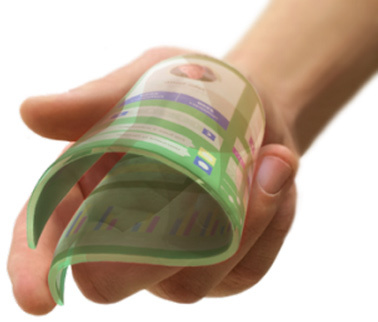The film with "nanoparticles" turns almost any surface into a touchscreen
 Finnish startup Canatu has developed a flexible, electrically conductive touchscreen film that can lead to the emergence of fundamentally new mobile gadgets of any shape.
Finnish startup Canatu has developed a flexible, electrically conductive touchscreen film that can lead to the emergence of fundamentally new mobile gadgets of any shape. Imagine your smartphone bending and folding like a piece of paper. If you make a screen out of such a film, then designers will open a huge field for the implementation of the craziest ideas.
You can attach a touchscreen to various elements of a curved shape. For example, on the dashboard of a car or on the steering wheel of a bicycle, or on a wire from the headphones. This is how new management interfaces are implemented. Commands are given by touching the wire or the steering wheel.
Moreover, such material, for example, is sewn into clothes or wound directly on the wrist. That is, the touchscreen is literally worn on the body.
Conventional touchscreens are made from transparent sheets of indium tin oxide (ITO). But this semiconductor material can only be applied on a flat surface, moreover, the sheets are very fragile and easily damaged.
 Different types of Canatu films are made with a coating of so-called carbon “nanoparticles” (Carbon NanoBud is a registered Canatu trademark). They are depicted in the illustration. These structures conduct the electrical signal more stably than carbon nanotubes. Researchers managed to improve the quality of electrical contacts by changing the shape of "pimples." The resulting film is stretched to 200% of its area. This is a much better indicator than other flexible touchscreens that stretch no more than a few percent.
Different types of Canatu films are made with a coating of so-called carbon “nanoparticles” (Carbon NanoBud is a registered Canatu trademark). They are depicted in the illustration. These structures conduct the electrical signal more stably than carbon nanotubes. Researchers managed to improve the quality of electrical contacts by changing the shape of "pimples." The resulting film is stretched to 200% of its area. This is a much better indicator than other flexible touchscreens that stretch no more than a few percent.The process takes place in one stage, which involves the deposition of carbon-containing gas on the surface of the film with the simultaneous formation of nanostructures of the desired shape. True, the electrical conductivity of the touchscreen is not high enough to cover very large areas.
At the moment, Canatu is working on 40 prototypes of different films, each of which is designed for its own application, including for covering the screens of smartphones, smart watches or more extensive surfaces, like a car dashboard.
The founders of Canatu are confident that flexible displays have a future and they will become mainstream within 2-5 years. The company expects next year to reach production capacities sufficient to produce touchscreens for millions of smartphones per month.
via Technology Review
